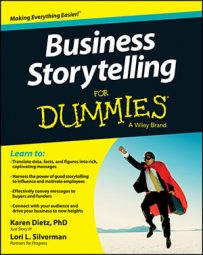Enhancing your storytelling skills involves more than listening, valuing your stories, being vulnerable, and knowing the difference between transactional and transformational storytelling. It’s also about reading your audience and delivering the stories well.
Know when to speed up and slow down
Rhythm in storytelling occurs through pacing and pausing (for example, fast–pause–slow–pause–fast) and repetition (“around and around they went . . .”). Pacing — slowing down and speeding up as you tell different sections of a story — is a way to build variety into your delivery. It can also wake people up and keep them involved and engaged in your story.
Hail to the power of the pause! Often people are so excited to tell a story that they forget to breathe. Pausing is powerful: It’s a way to wake people up and build their anticipation for what’s coming next. It builds drama and tension.
Pausing during select moments while telling a story also allows people to keep up with you and process what you’re saying. As you speak, they’re feasting on your images — digesting them and making them their own. Sometimes there’s a lag between an image you deliver and the mind of the listener who’s internalizing it. Make time for this.
Try these skills. Without any pausing, pacing, or repetition, speak the next paragraph out loud.
For a while, the county had been working with a coalition of community groups and city staff to implement a 50-mile bike path through the city and the back country. The project would increase parkland along the corridor, commuting to work by bike, and the safety of the roadways. Everyone agreed on the value of the project.
Now, add in pauses, pacing, and repetition and hear the difference.
For a while, [pause] the county had been working with a coalition of community groups and city staff [pause] to implement a 50-mile bike path through the city and the back country. [pick up the pace] The project would increase parkland along the corridor commuting to work by bike, and the safety of the roadways. [slow down now] Everyone, everyone [repetition] agreed on the value of the project.
Build pauses, pacing, and repetition into your story judiciously. You’ll know you have a good balance of rhythm and repetition when a story captivates listeners — you’ll feel people physically move with you as you share the story, and they’ll describe the story as being in sync with their experience.
Identify characters: Gestures and voice
Here’s a chance to have fun when telling a story: Add different voices and mannerisms to characters. Doing so brings characters to life and helps listeners distinguish among them and engage more easily with the story.
The question of how physical and expressive a teller should be while sharing a story is a common one. A storyteller who traverses the entire width of the front of a room when sharing their stories can be equally entrancing as one who sits still on a piano bench.
In general, it’s less about being theatrical or reserved and more about what comes natural. If you’ve crafted your story well, your sharing and body movements will flow naturally and be authentic because you’re in the zone.
Whether a story is compelling is driven primarily by how well it’s structured. However, assuming you’re telling your own story, there’s nothing wrong with enhancing your delivery of you. Maybe you need to tone down flailing your arms and pacing across the stage. Or maybe you need to add some hand or arm movements or exaggeration for a humorous effect.
Your delivery should be neither distracting nor mousy. Find the sweet spot between driving home your key message and moving people to action, without being disingenuous. This may mean stretching beyond what’s comfortable.
When it comes to how you project the other characters in your stories, there are lots of ways to make each character unique. An easy way is to mirror their behaviors — act like them.
Talk the way they talk. If they have a British accent, work on making your voice sound that way. If they laugh in a unique way, reproduce it. Stand the way they stand. If they tend to pace back and forth when they speak, do that. Gesture the way they gesture. Use the same facial expressions. We’re not talking about mocking anyone, only imitating them. Bring these characters to life.
When depicting various characters, you may want to stand (or sit, if the story calls for it) in different places in the room. This is especially important when you’re delivering dialogue between two characters. There are also techniques you can use to roll back and forth between them while relaying a conversation without saying, “I said . . . and then she said back to me . . .”
One of these is called “The Two Character Two Step,” where you position your body 45 degrees to the left of center for one character and then shift 45 degrees to the right of center for another, while also switching how you gesture. For further information, check out Doug Stevenson’s Story Theater Method: Strategic Storytelling in Business (Cornelia Press, 2008).
“Where do I look with my eyes?” is a common question about how to share internal dialogue: Look anywhere except at the people with whom you’re sharing the story. You might look down or off into the horizon, or off to one side, as you would if you were talking to yourself.

